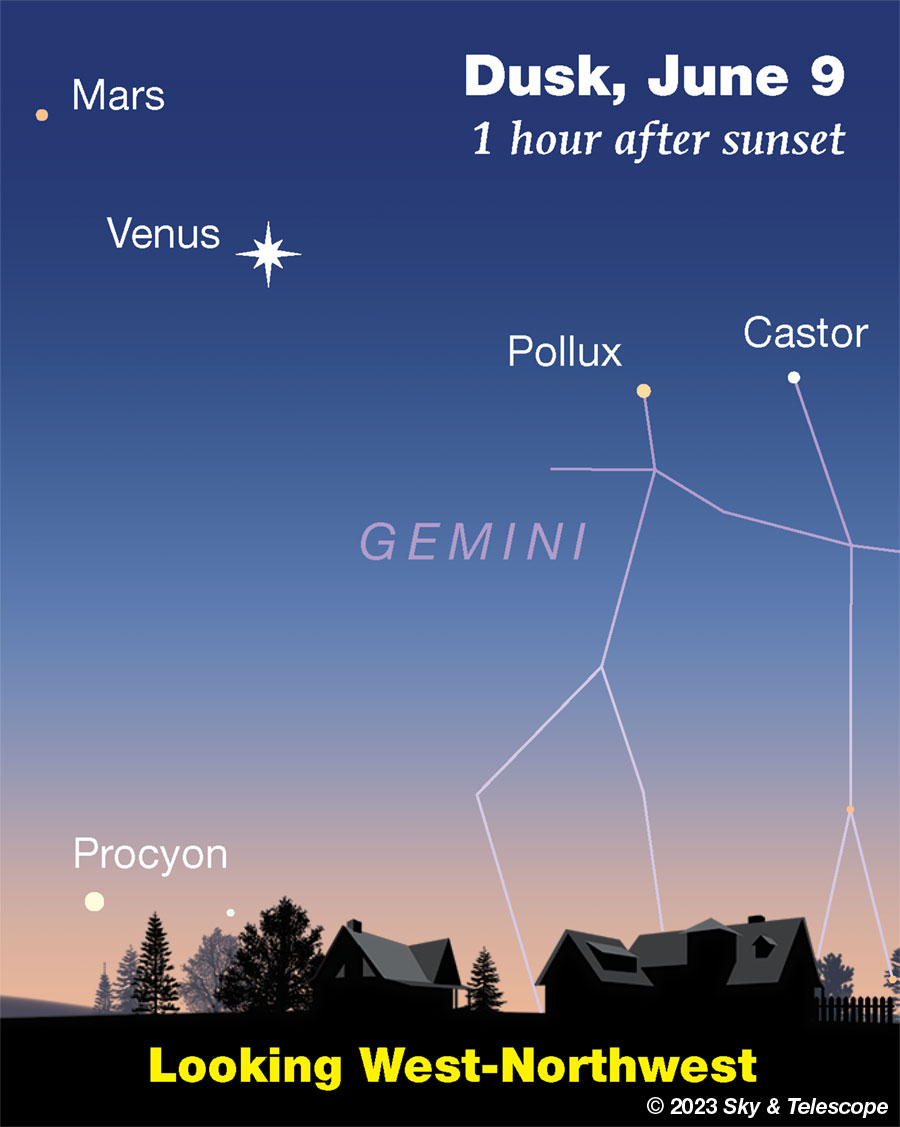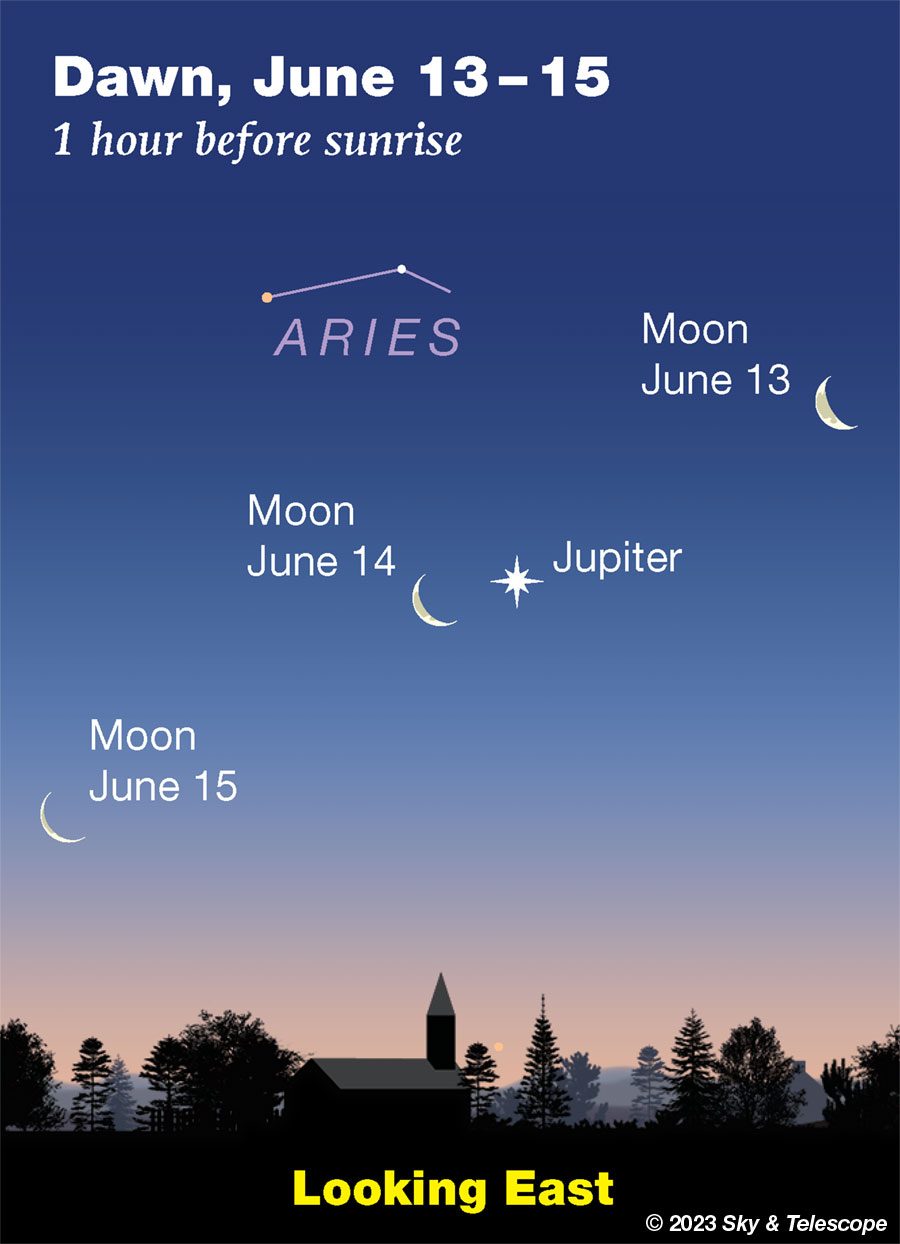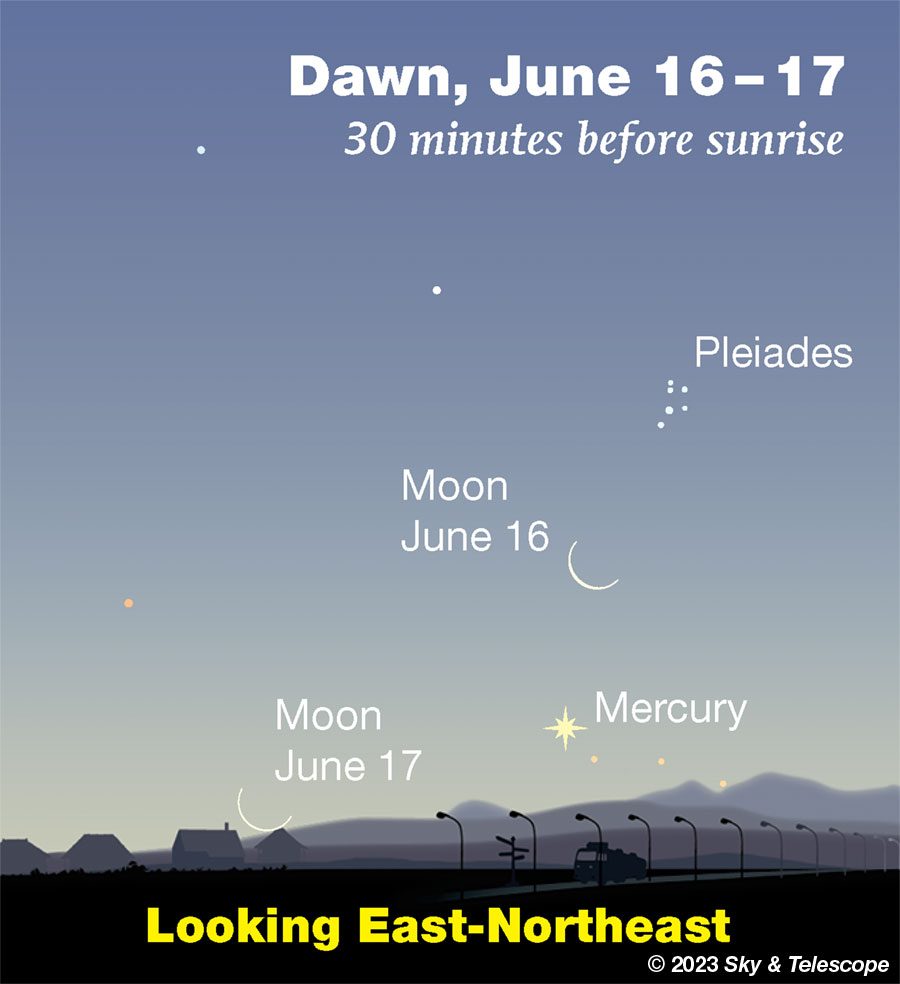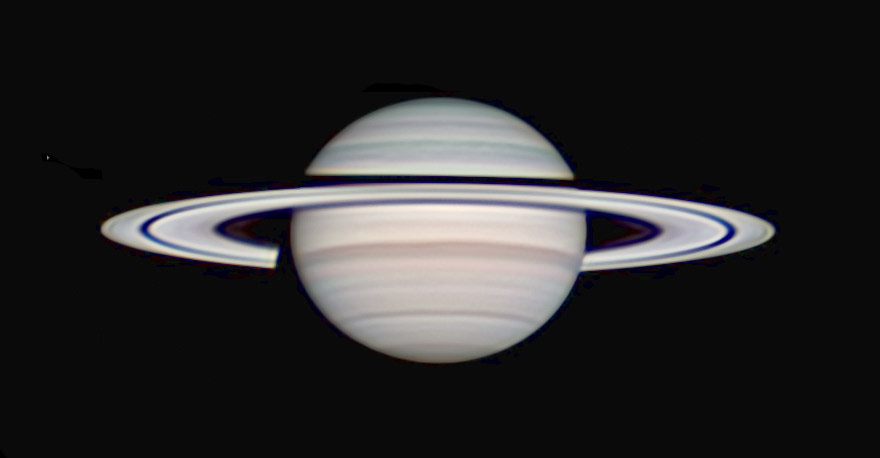Supernova in the Pinwheel Galaxy, update June 9: The sky is now moonless after dark. And Supernova 2023ixf in M101 off the Big Dipper has only faded a trace, to magnitude 11.4 from its peak of magnitude 11.1 around May 25th.
Supernovae usually stay bright for weeks, sometimes with surprise variations. See Bright Supernova Blazes in M101, the Pinwheel Galaxy, with charts and comparison magnitudes. Witness a single, individual star 21 million light-years away. Unless you've seen telescopic supernovae before, this will be your stellar distance record by far — by a factor of several hundred at least.
FRIDAY, JUNE 9
■ The Big Dipper hangs high in the northwest as the stars come out. The Dipper's Pointers, currently its bottom two stars, point lower right toward Polaris. Above Polaris, and looking very similar to it, is Kochab, the lip of the Little Dipper's bowl. (The rest of the Little Dipper is mostly dim.)
Kochab stands precisely above Polaris around the end of twilight or a little after. How accurately can you time this event for your location, perhaps using the vertical edge of a building?

■ Saturn rises around 1 a.m. Saturday morning (daylight-saving time), followed less than a half hour later by the Moon, 6° or 7° to Saturn's lower left and nearly last quarter. By early dawn the two of them are well up in the southeast.
SATURDAY, JUNE 10
■ Spica is straight below Arcturus not long after dark. Half as far to Spica's lower right is the four-star pattern of Corvus, the springtime Crow, rather compact. Spring will soon be over; catch Corvus before it sinks too low and departs from the evening sky until next year.
■ Last-quarter Moon (exact at 3:31 p.m. EDT). The Moon rises tonight around 2 a.m. daylight-saving time. Upper left of it will be the Great Square of Pegasus, and upper right of the Moon glows Saturn.
SUNDAY, JUNE 11
■ Here it is almost summer. But as twilight fades, look very low in the north-northwest for wintry Capella very out of season. The farther north you are, the less low it will be. You may need binoculars. If you're as far north as Montreal or either of the Portlands (Oregon or Maine), Capella is actually circumpolar.
MONDAY, JUNE 12
■ Venus is passing just north (upper right) of the Beehive Cluster, M44 in Cancer, this evening and tomorrow evening. The brilliant planet and faint cluster are separated by hardly 1°. Use binoculars or a wide-field telescope. Modest Mars traversed nearly the same route ten days ago.
TUESDAY, JUNE 13
■ Before and during early dawn Wednesday morning the 14th, Jupiter shines a couple degrees to the right of the thin crescent Moon. Look for them low in the east, as shown below.

WEDNESDAY JUNE 14
■ Leo's tail star, 2nd-magnitude Denebola high in the south-southwest after dark, forms an almost perfectly equilateral triangle with brighter Spica off to its left and Arcturus, brighter still, high above them. All three sides of the triangle are close to 35° long (35.3°, 35.1°, and 32.8°). S&T columnist George Lovi named this the Spring Triangle nearly a half century ago, but the name never really caught on. For such a near-perfect equilateral, I think its special name ought to be revived.
THURSDAY, JUNE 15
■ Vega is the brightest star high in the east after dark. Barely lower left of it is 4th-magnitude Epsilon Lyrae, the Double-Double. Epsilon forms one corner of a roughly equilateral triangle with Vega and Zeta Lyrae. The triangle is less than 2° on a side, hardly the width of your thumb at arm's length.
Binoculars easily resolve Epsilon. And a 4-inch telescope at 100× or more should resolve each of Epsilon's wide components into a tight pair.
Zeta Lyrae is also a double star for binoculars; much tougher, but plainly resolved in any telescope.
Delta Lyrae, below Zeta, is a much wider and easier pair, orange and blue.
■ As dawn brightens on Friday morning, the thin waning crescent Moon low in the east directs you down to Mercury below it. Mercury is now usually bright, magnitude –0.8.

FRIDAY, JUNE 16
■ As we count down the last five days to summer (the solstice is on June 21st), the Summer Triangle stands high and proud in the east after dark. Its top star is bright Vega. Deneb is the brightest star to Vega's lower left, by 2 or 3 fists at arm's length. Look for Altair a greater distance to Vega's lower right. Altair is midway in brightness between Vega and Deneb.
If you have a dark sky, the Milky Way runs across the lower part of the Summer Triangle from side to side.
As night progresses, look lower left of Altair for little Delphinus, the leaping Dolphin.
SATURDAY, JUNE 17
■ After dark look south-southeast for orange Antares, "the Betelgeuse of summer." (Both are 1st-magnitude "red" supergiants). Around and upper right of Antares are the other, whiter stars of upper Scorpius, forming their distinctive pattern. The rest of the Scorpion curls down toward and along the horizon.
And spot Arcturus way up high toward the south. Three fists below it is Spica. A fist and a half to Spica's lower right, four-star Corvus, the Crow, is heading down and away.
SUNDAY, JUNE 18
■ Leo the Lion is mostly a constellation of late winter and spring. But he's not gone yet. As twilight ends look upper left of Venus and Mars for Regulus, his brightest and now lowest star: the forefoot of the Lion stick figure.
The Sickle of Leo, the Lion's front part, extends upper right from Regulus. The Sickle is heading for the two planets. The rest of the Lion's constellation figure extends for almost three fist-widths to the upper left, to his tail star Denebola, the highest.
He'll soon be treading off into the sunset.
■ New Moon (exact at 12:37 a.m. on this date EDT).
This Week's Planet Roundup
Mercury remains deep in the glow of sunrise, as it will continue to do for the rest of this apparition. But even so it brightens from magnitude –0.3 to –0.8 this week. That's almost as bright as Mercury gets when it's visible at all.
Try for it 30 or 40 minutes before sunrise, well to the lower left of brighter Jupiter. The two planets are moving apart: from 22° separation on the morning of June 10th to 34° on the 17th.
Venus (magnitude –4.5, in Cancer) is the brilliant "Evening Star" in the west from twilight into late evening. It's not as high in the dusk as it was a couple weeks ago, but it doesn't set until more than an hour after full dark.
In a telescope Venus is a thick crescent, dazzlingly white, about 27 arcseconds from pole to pole. Venus will become a bigger, thinning crescent dropping lower until it's lost from sight in mid- to late July.
Mars (magnitude 1.7, also in Cancer) glows weakly to Venus's upper left, by a slowly shrinking distance: 8° on the evening of June 9th, 5½° by June 16th.
But no conjunction is in store. Mars and Venus will reach a minimum separation of 3.6° on June 30th, then they'll start to draw apart again as Venus plunges down toward the sunset. This is called a quasi-conjunction, because they don't pass each other although they do get within 5° of each other.
In a telescope Mars is just a tiny little blob 4½ arcseconds in diameter, since it's on the far side of its orbit from us.
Jupiter (magnitude –2.1, in Aries) shines low in the east before and during early dawn.
Saturn (magnitude +0.9, in dim Aquarius) is nicely up in the southeast before dawn.

Also notice the black on each side of the rings where they cross the planet's disk. The dark black south of (above) the rings is their shadow on the globe. The thinner, slightly grayer black to their north is the dim, sparse inner C ring, seen in front of the planet's bright face.
Uranus, magnitude 5.8, is hidden low in the dawn.
Neptune, magnitude 7.9 at the Aquarius-Pisces border, is up in the east-southeast before dawn begins, some 20° east of Saturn.
All descriptions that relate to your horizon — including the words up, down, right, and left — are written for the world's mid-northern latitudes. Descriptions and graphics that also depend on longitude (mainly Moon positions) are for North America.
Eastern Daylight Time (EDT) is Universal Time minus 4 hours. UT is sometimes called UTC, GMT, or Z time.
Want to become a better astronomer? Learn your way around the constellations. They're the key to locating everything fainter and deeper to hunt with binoculars or a telescope.
This is an outdoor nature hobby. For a more detailed constellation guide covering the whole evening sky, use the big monthly map in the center of each issue of Sky & Telescope, the essential magazine of astronomy.
Once you get a telescope, to put it to good use you'll need a much more detailed, large-scale sky atlas (set of charts). The basic standard is the Pocket Sky Atlas (in either the original or Jumbo Edition), which shows all stars to magnitude 7.6.

Next up is the larger and deeper Sky Atlas 2000.0, plotting stars to magnitude 8.5; nearly three times as many. The next up, once you know your way around, are the even larger Interstellarum atlas (stars to magnitude 9.5) or Uranometria 2000.0 (stars to mag 9.75). And be sure to read How to Use a Star Chart with a Telescope. It applies just as much to charts on your phone or tablet as to charts on paper.
You'll also want a good deep-sky guidebook. A beloved old classic is the three-volume Burnham's Celestial Handbook. An impressive more modern one is the big Night Sky Observer's Guide set (2+ volumes) by Kepple and Sanner.
Can a computerized telescope replace charts? Not for beginners, I don't think, and not on mounts and tripods that are less than top-quality mechanically. And as Terence Dickinson and Alan Dyer say in their Backyard Astronomer's Guide, "A full appreciation of the universe cannot come without developing the skills to find things in the sky and understanding how the sky works. This knowledge comes only by spending time under the stars with star maps in hand."
![]() Audio sky tour. Out under the evening sky with your
Audio sky tour. Out under the evening sky with your
earbuds in place, listen to Kelly Beatty's monthly
podcast tour of the heavens above. It's free.
"The dangers of not thinking clearly are much greater now than ever before. It's not that there's something new in our way of thinking, it's that credulous and confused thinking can be much more lethal in ways it was never before."
— Carl Sagan, 1996
"Facts are stubborn things."
— John Adams, 1770
 2
2









Comments
Tony
June 12, 2023 at 11:02 am
The remark about Venus getting lost in mid-to-late July applies to mid and high northern latitudes. Where the inclination of the ecliptic is steeper, in the tropics and Southern Hemisphere, Venus will remain eye-catching all through July. At that month's end, it'll be 20 degrees from the Sun, good for setting more than an hour after the Sun at Nairobi and Quito, and a full two hours at Puntas Arenas and Ushuaia.
You must be logged in to post a comment.
Rod
June 12, 2023 at 10:32 pm
Okay, skies clearing, some rain passed today and earlier, smoke and haze 🙂 I could see various stars and constellations tonight. Ursa Major, Ursa Minor, Vega in Lyra, Arcturus, Hercules, Cygnus, and others. Perhaps tomorrow night, some stargazing. I went outside a bit ago and checked conditions, definitely improving at my location in MD.
You must be logged in to post a comment.
You must be logged in to post a comment.